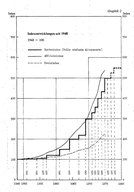
Unternavigation
During the boom of the 1960s and early 1970s, inflation rates of up to ten percent resulted in the continued devaluation of AHV and IV pensions. According to the 1972 revision of the Federal Constitution (Art. 34quater), pensions had to be regularly adjusted for inflation. This was the only way to ensure the constitutional aim of subsistence-level pensions. Until 1972, each and every pension adjustment had required a separate parliamentary approval. The 9th AHV revision gave the Federal Council the authority to carry out these adjustments independently every two years, although this interval could be shortened or extended depending on the economic situation.
Various modes of calculation were discussed in the run up to the 9th AHV revision. After 1974, discussions on pension adjustments became embroiled in the whirl of arguments surrounding the consolidation of the AHV. The first draft (1973) enabled the Federal Council to flexibly adjust pensions to inflation or wage development depending on economic conditions. At the time, this favorable model for pensioners was referred to as ‘Volldynamisierung’ or ‘automatic indexing’. However, the adjustment mechanism that entered legislation in 1979 followed the more conservative method of ‘proportional indexing’. A composite index was – and still is – applied. The index equates to the mean from the wage index of the former Federal Office for Industry, Trade and Labour (BIGA, now: State Secretariat for Economic Affairs, Seco) and the national consumer prices index. Wage and price trends are therefore both taken into account equally.
Literatur / Bibliographie / Bibliografia / References: Leimgruber Matthieu (2008), Solidarity without the state? Business and the shaping of the Swiss welfare state, 1890–2000, Cambridge; Ischer Philipp (2006), Ausbau oder Konsolidierung? Der politische Diskurs der 1970er Jahre in der Schweiz im Bereich der AHV, Studien und Quellen, 31, 141–166.
(12/2014)




